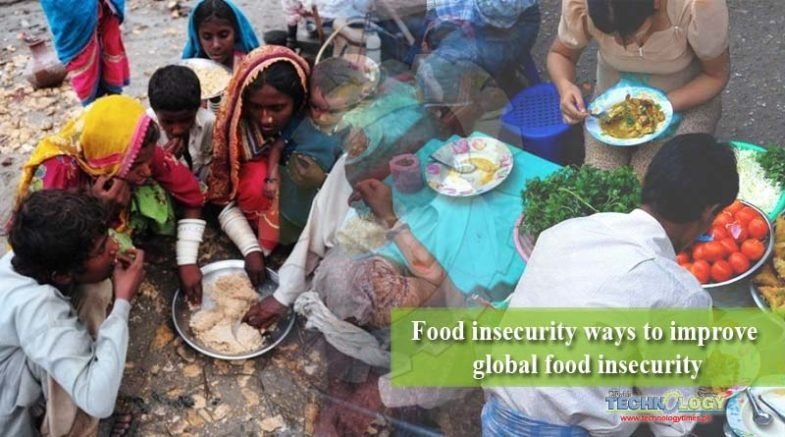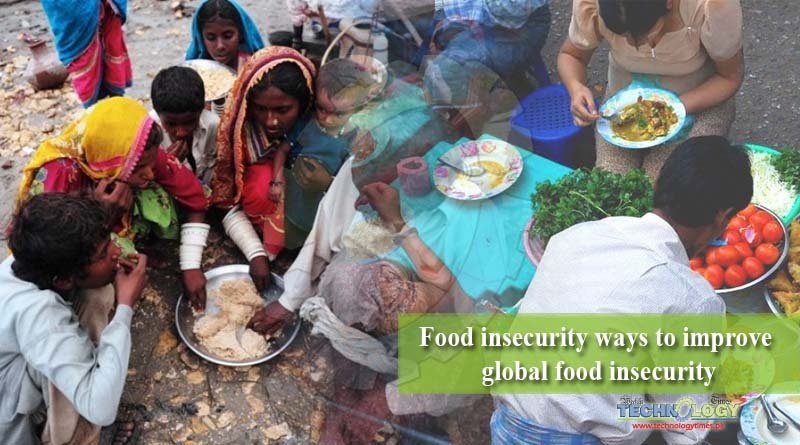Food insecurity is “the state in which there is no reliable access to sufficient, nutritious and affordable food for the peoples”. Whereas Food security is defined as “All individuals at all time have social, economic and physical access to safe, Sufficient, healthy and nutritive food to maintain and healthy life”.
 Food insecurity is one of the most embarrassing and exclusive problem of all over the world especially for the third world Asian country like Pakistan. According to some studies every day more than 800 million peoples live with hunger or food insecurity and go for sleep. Food insecurity is the main factor for the malnutrition and it is also responsible for the Hunger. It became alarming threat in near future for the world. Food insecurity is also due to the human made activities which effect the climate badly and that are the main reason for this threat.
Food insecurity is one of the most embarrassing and exclusive problem of all over the world especially for the third world Asian country like Pakistan. According to some studies every day more than 800 million peoples live with hunger or food insecurity and go for sleep. Food insecurity is the main factor for the malnutrition and it is also responsible for the Hunger. It became alarming threat in near future for the world. Food insecurity is also due to the human made activities which effect the climate badly and that are the main reason for this threat.
Losses of High waste and food depends on specific condition:
Precise estimations of the size of misfortunes and waste are missing, especially in creating nations. In any case, there is no uncertainty that nourishment misfortune and waste remain in admissibly high concentrates charged by FAO evaluated yearly worldwide nourishment misfortune and waste by amount at about 30 percent of grains, 40–50 percent of root yields, foods grown from the ground, 20 percent of oil seeds, meat and dairy items, and 35 percent of fish. Nourishment misfortune and waste are vigorously reliant on the particular conditions and neighborhood circumstance in a given nation or culture. In low-salary nations nourishment misfortune results from wide-going administrative and specialized impediments in reaping methods, stockpiling, transportation, handling, cooling offices, foundation, bundling and advertising frameworks.
The principle areas of concern are little and medium-scale fisheries, farming generation and handling. Social and social conditions for example, the distinctive gainful and social jobs that people play at various phases of the worth chain are additionally regularly hidden reasons for nourishment misfortune. In provincial settings, while ladies are frequently the fundamental on-screen characters in agribusiness, post-collect taking care of and promoting, social obstructions may hinder their association in different phases of the chain. The troubles that ladies face in getting access to and profits by assets, administrations, employments and salary creating exercises influence their profitability and effectiveness in nourishment generation, and can prompt nourishment misfortune.
The reasons for nourishment squander in medium-and high-salary nations relate chiefly to buyer conduct and the arrangements and guidelines set up to address other sectorial needs. For instance, agrarian sponsorship may add to the generation of surplus amounts of ranch crops, of which at any rate an extent is lost or squandered. Sanitation and quality guidelines can be applied in manners that evacuate nourishment that is as yet OK for human utilization from the nourishment store network. At the buyer level, deficient arranging of buys and inability to utilize nourishment before its expiry date likewise lead to avoidable nourishment squander.
The impacts of food loss and waste are multifaceted nourishment misfortune and waste have negative ecological effects in light of the water, land, vitality and other normal assets used to deliver nourishment that nobody devours. The size of the effect increments with the degree of preparing and refining of the nourishment items, and the stage (upstream or downstream) in the nourishment inventory network at which the nourishment is lost or squandered. By and large, lower misfortunes are related with higher effectiveness in the nourishment supply, and in the long run with progressively compelling reusing of assets, lower stockpiling needs, shorter vehicle separations, and less vitality use. Nonetheless, answers for lessening misfortunes regularly lead to expanded utilization of vitality, particularly for the conservation of nourishment items. Clearly, from the ecological perspective, the negative effects of measures to diminish nourishment misfortune and waste ought to be lower than the advantages.
The non-gainful utilization of characteristic assets, for example, land and water that outcomes from nourishment misfortune and waste has repercussions on appetite and destitution easing, sustenance, salary age and financial development. In the subsistence cultivating frameworks of poor smallholder makers, quantitative misfortunes result straightforwardly in less nourishment being accessible, and consequently add to nourishment uncertainty. Ladies ranchers and little youngsters in many creating nations are especially liable to endure this effect, as they regularly have less access than different gatherings to fitting advancements, framework, storerooms and markets.
Subjective nourishment misfortune may cause decreased wholesome status, while low-quality items may likewise be risky as a result of their unfavorable impacts on the well being, prosperity and efficiency of customers. Nourishment misfortune speaks to lost monetary worth financial incentive for on-screen characters in the nourishment generation and supply chains. The estimation of nourishment lost or squandered every year at the worldwide level is assessed at US$ 1 trillion. The present nourishment supply chains are progressively globalized, with certain nourishment things being delivered, prepared and devoured in totally different pieces of the world. Nourishment items exchanged on global markets and squandered in one piece of the world could influence nourishment accessibility and costs in different parts.
Following are some practices to overcome food insecurity
1: Close the yield gap
According to the world wildlife fund estimates, by 2050, In the developing countries about 120 million hectares of natural habitats will be converted to farm lands. Around the globe in many regions yield is about 50% less then what it could be produce existing cultivable lands does not meet its real potential for production. Gap between what could be produce and what is being produce it would both reduce the necessities to clear the agricultural land and provide the food to the 850 million peoples.
2: Efficient use of fertilizers:
Farmers moves toward inorganic source of fertilizer instead of organic fertilizers to get the required potential of the crop in the one growing season. Inorganic fertilizer has the adverse effect on the soil health. Used of Synthetic fertilizers in large quantity add nutrients to the soil temporarily but it can’t store nutrients in the soil for the longer period of time. On the basis of previous study, it is predictable 13-29 percent could be producing the same yield which is taken by the Use of fertilizer such that phosphorus and nitrogen on maize, rice, wheat.
3: Raise low water productivity:
Today Climate change is the major problem of all over the world. Pakistan and other Asian countries face this problem and adversely effects the water tables and hydro logical cycles as well as it effects the environment. Now a day’s water scarcity is the major issue and threat to food security and agriculture. Many times, it has been written to tackle this issue adopt the appropriate patterns, schemes and planting geometry of crop raising and modern irrigation system to minimize this effect. For example, Sugarcane and rice are the crops which grown under high delta of water. Traditionally farmers grow puddled rice on there forms instead of puddled rice, Direct seeded rice (DSR) can be grown which have low delta of water and also increase the water use efficiency of sugarcane crop by cultivate it on ridges instead of pits. Like wise use of water can be reduce by modern irrigation and crop cultivation methods.
4: Reduce wastage of food:
Globally, Food wastage is an epidemic due to inadequate facilities of storage and unappropriated way for the production of food is also a huge threat to food security. Food insecurity can be overcome by reduce the wastage of food. Globally about 30-45% of food goes to wasted. More than one-third of all food produced globally is wasted or spoiled. Americans throw away up to 40% of the food they buy, and organic matter in landfills provides 20% of all methane emissions, a potent greenhouse gas that contributes considerably to climate change. Some practically practiced ways to reduce the wastage of food to prevent from food insecurity.
- Buy according to your desire and need.
- 2: Cooked food doesn’t over serve.
- Don’t garbage the extra food.
- For extra food savage, place should be clean, and right.
- Ensure prevention of clutters in your fridge, freezer, Pantry.
- Treat expiration and sell-by dates as guidelines.
- Keep track of what you throw away.
Recommendation:
Due to high wastage of food and food products population in the developing countries face malnutrition and it should necessary to focus on the food security to overcome this problem worldwide, especially in Asian and African countries of the world.
